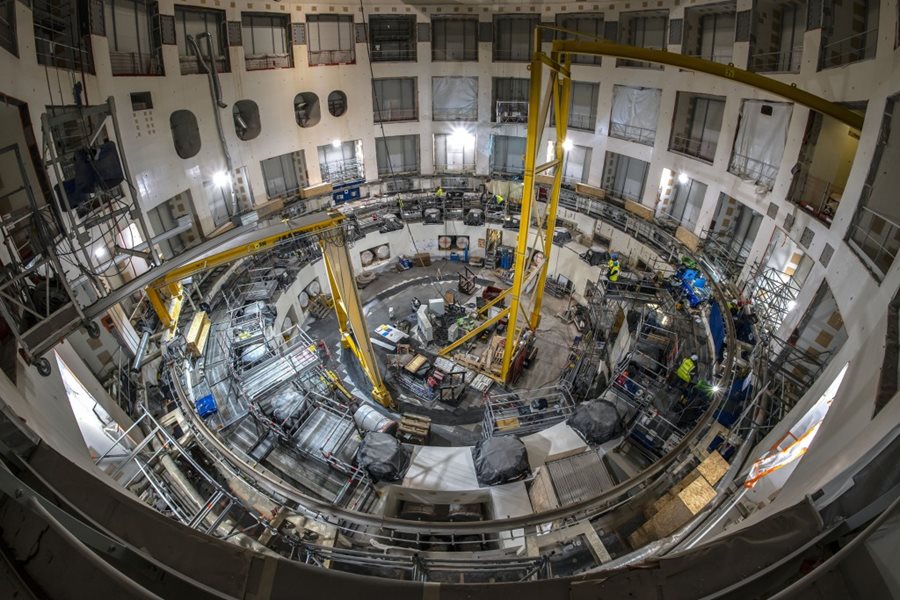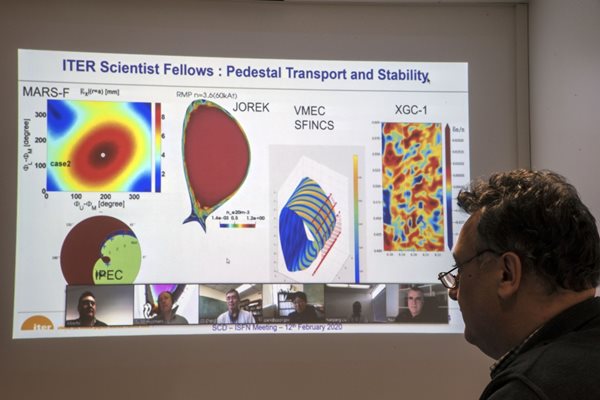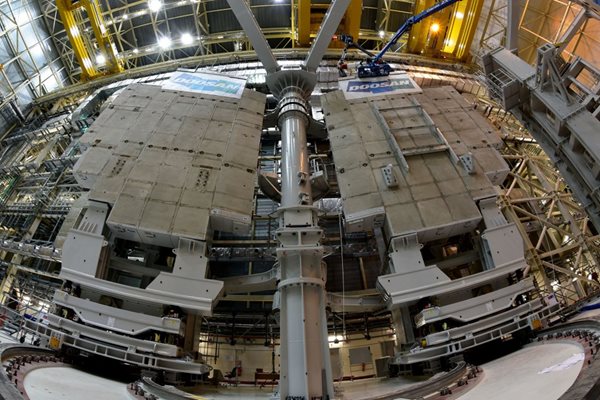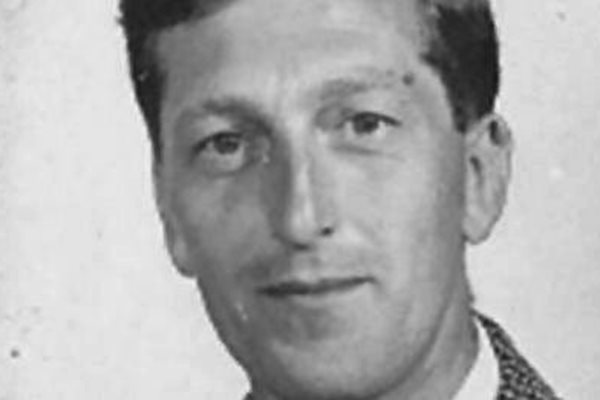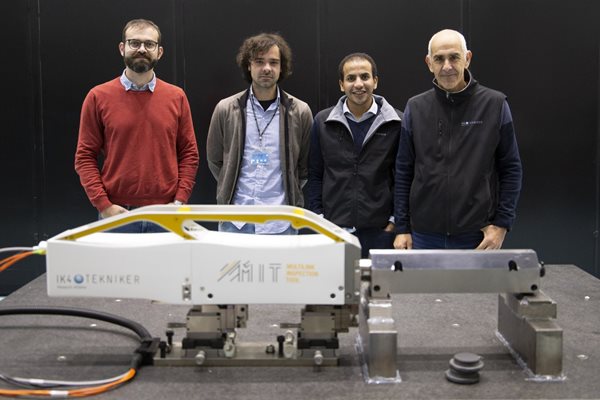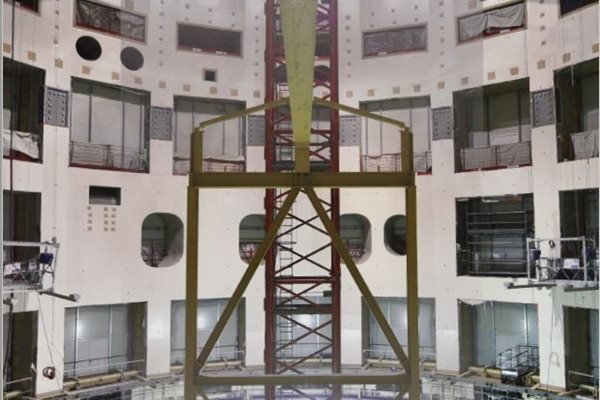
you're currently reading the news digest published from 10 Feb 2020 to 17 Feb 2020
featured4
of-interest2
video1
press9
featured
Cryostat base | Grand opening soon
Picture a giant soup plate, 30 metres in diameter, slowing descending into a deep concrete cylinder. Track the near imperceptible movement of the double overhead bridge crane, as it moves a few millimetres at a time to align the plate's rim with prepared supports 60 metres below. Feel the tension as the operation unfolds and the 1,250-tonne steel component eventually settles with submillimetre precision on the massive concrete 'crown' waiting below. And mark your calendars, because what you have just visualized will be the opening act of ITER machine assembly this spring—the insertion of the cryostat base into the Tokamak pit. The cryostat base, part of the insulating vessel that encases the ITER Tokamak, is the heaviest of all the machine components. As the first of four cryostat sections to be lowered into the Tokamak pit, it must be aligned with utmost precision as any departure from its nominal positioning would affect the entire structure of the 30-metre-tall cryostat. Aligning such a large and heavy component to its predefined position requires a constant interaction between high-precision mechanics and laser metrology. 'The crane itself is a high-precision tool, capable of micro-movements on the order of a few millimetres,' explains Guillaume Vitupier, an engineer in the ITER Cryostat & Auxiliaries Group. Throughout the load's descent, a set of laser beams from trackers located in the port cells that open into the pit will interact with metrology targets affixed to the component. Computed information from this three-dimensional system will be available in real-time to the crane operator, who will minutely adjust the movement of the girders and trolleys. 'At any given moment, we will know exactly where the load stands relative to the referential,' says Guillaume. The concrete 'crown' upon which the cryostat base will ultimately rest is equipped with different types of supports, whose function is to maintain the component in place while accommodating the movement caused by the tremendous forces at work in the machine. As a consequence, the support system needs to be both extremely robust, with a strong connection to the Tokamak Complex basemat and bioshield walls, and yet flexible enough to allow some 'breathing space' for to the colossal mass of the Tokamak enclosed in its insulating cryostat (23,000 tonnes). A set of 18 spherical bearings, evenly spaced and deeply anchored into the 'crown,' will bear the full weight of the machine and, acting as ball-and-socket joints, will enable the smooth transfer of horizontal and rotational forces, whether stemming from normal operations, a vertical displacement event or an earthquake. Another set of supports, anchored and bolted into the bioshield wall, complements the action of the bearings: 18 'female lugs'—designed to match the male counterparts protruding from the cryostat pedestal rim (like mortise and tenon)—will act as transversal support, allowing the machine to 'breathe' outward while countering any horizontal displacement. However careful the controls and measurements performed throughout the manufacturing process, the 'as built' reality of a component (especially one as large as the cryostat base) always presents some degree of deviation from its reference design. At the points of interface between the component and its supports, it is absolutely crucial to compensate for these minute variations. When the component has been lowered to a distance of some 6 to 7 centimetres above the bearings, the load will be progressively transferred from the crane to a set of 12 vertical hydraulic jacks. 'At this point, we will be able to survey the deviation of the 'as-built' interface and proceed to the machining of tailor-made shims,' says Guillaume. A similar operation will be performed at the male-female lug interface, this time with horizontal alignment jacks. From the moment the overhead crane positions the cryostat base vertically above the pit to the final positioning of the load, one or two days will elapse—the first act of a grand, complex and delicate enterprise, ITER machine assembly, that will end in late 2024.
Research | ITER Scientist Fellows are at the cutting edge
In the area of cutting-edge research—and particularly the sophisticated modelling of plasmas—the project is benefitting from the assistance of world-renowned experts through the ITER Scientist Fellow Network program. Now into its fourth year, the program is beginning to produce concrete results. 'When we want to do detailed studies for the planning of operations using established codes and approaches, we usually place contracts for which leading Member institutes compete,' points out Alberto Loarte, head of the ITER Science Division. 'With the Scientist Fellow Network we are aiming for something quite different: encouraging state-of-the-art development in simulation and theory for ITER through advanced calculations and cutting-edge research.' The Fellows focus on areas of interest to the ITER team but which also advance their own research objectives—for example, developing new models to apply to plasma simulations or using known codes in novel ways. 'The results are never guaranteed, however. This is a research activity.' Sixty-six scientists are currently collaborating as ITER Scientist Fellows, organized into groups of 4 to 20 by theme (see box). Six groups are managed within the Science Division; a seventh has been created in the area of diagnostics. Every scientist has an annual work plan, and one or two coordination meetings are planned yearly at the ITER site during which the Fellows present their results, hear about the work of other Fellows and ITER Organization scientists working in the same area, and are kept abreast of ITER developments (updated plasma scenarios, design changes, etc.). Outside of these on-site meetings, much of the day-to-day work between the Fellows and the ITER coordinators takes place by email and teleconference. 'The ITER Scientist Fellow program allows us to bring together world-renowned experts from different laboratories around areas of specific development for ITER. With time, we are seeing a very productive dynamic within the groups, as well as a certain amount of cross-fertilization between areas. As we move forward with the understanding of ITER plasmas, which is required to plan the experiments, the contributions of the Fellows are proving increasingly valuable.' And the results are increasingly visible in the fusion community. 'After two or three years of build-up, depending on the group, we are now in production mode,' says Alberto. 'Output from the ITER Scientist Fellow program was featured at major conferences and specialized workshops in 2019, including invited presentations (e.g., at the American Physics Society Division of Plasma Physics Conference, the Workshop on Tritium Transport Modelling in Nuclear Fission and Fusion, etc.) and publications in high-impact journals in the field such as Nuclear Fusion, Physics of Plasmas, Plasma Physics and Controlled Fusion, etc.). This brings recognition to the individual scientists as well as to their home labs.' As a result of the quality and the increased visibility of the work carried out by the Fellows, the ITER Organization is seeing a rise in nominations. The typical nominee for the fellowship program has a strong international reputation in his or her area of expertise, often leading teams of scientists in their home institutes. Fellows commit to spending a substantial part of their time working on ITER-related issues, with multi-annual research programs and targeted annual goals. Fellows are named for three years and the appointments are renewable. Since the start of the program in 2016, more than 80 percent of the early participants have been renewed. 'The program has been instrumental in increasing the community's sense of ownership of ITER's science,' says Alberto. 'As we prepare for the scientific exploitation phase of the device, this network of scientists involved directly in advanced modelling of ITER plasmas will be irreplaceable.' Other Newsline articles are planned on the achievements of each group. For more information on the ITER Scientist Fellow program, please contact alberto.loarte@iter.org. Since 2016, ITER Scientist Fellows have been nominated by the following institutes: Aalto University (Finland)Australian National University (Australia) CEA Institute for Magnetic Fusion Research, IRFM (France) EPFL Swiss Plasma Center (Switzerland) EUROfusion VR/Chalmers (Sweden) Forschungszentrum Jülich - Plasmaphysik (Germany) Fudan University (China) General Atomics (US) Heinrich Heine Universität Düsseldorf (Germany) Institute of Plasma Physics, Chinese Academy of Sciences (China) Instituto de Plasmas e Fusão Nuclear, IST (Portugal) Instytut Fizyki Plazmy i Laserowej Mikrosyntezy, Warsaw (Poland) KTH Royal Institute of Technology (Sweden) Kurchatov Institute (Russia) Laboratoire des Sciences des Procédés et des Matériaux, CNRS (France) Laboratory for Plasma Physics - ERM/KMS (Belgium) Lehigh University (US) Max-Planck-Institut für Plasmaphysik, Garching (Germany) Nagoya University (Japan) National Institute for Fusion Science (Japan) National Institutes for Quantum and Radiological Science and Technology, QST (Japan)Peter the Great St Petersburg Polytechnic University (Russia) Princeton Plasma Physics Laboratory (US) Princeton University (US) Sino-French Institute for Nuclear Energy and Technology, Sun Yat-sen University (China) Southwestern Institute of Physics (China) Technische Universiteit Eindhoven (The Netherlands) UKAEA Culham Centre for Fusion Energy (UK)Universidad Carlos III de Madrid (Spain) Universidad de Sevilla (Spain) Université de Nice Sophia Antipolis (France) University of Basel (Switzerland)University of Texas, Institute for Fusion Studies (US)University of Wisconsin-Madison (US) Uppsala Universitet (Sweden) Ústav fyziky plazmatu AV ČR, (Czech Republic)
Image of the week | Testing the load path
Teams are preparing now for the commissioning and dynamic load tests that will be carried out in the coming weeks on the assembly bridge cranes. The load tests, which aim to demonstrate the structural integrity of the load path, were performed two years ago through the Assembly Hall; now, they must be repeated for the path that runs through the vast crane hall above the Tokamak Building (crane rails, runway beams, structural columns and the remainder of the civil works supporting the cranes). The commissioning activities in the crane hall will require approximately one month. At their conclusion, the cranes will return to the Assembly Hall to be equipped for a series of load tests, this time with a load that is representative of the major components to be handled during the assembly phase. In this second phase of testing, the bridge cranes will be fitted with two 350-tonne test loads (previously used to qualify the two vacuum vessel sector sub-assembly tools), plus additional loads to reach the required weight. Before the overhead cranes leave the Assembly Hall for testing next door, they have been used to raise the 350-tonne test loads back into the 'arms' of the sector assembly tools, where they are being equipped with frames (see right load) to carry the additional weight.
In memoriam | Physicist John Wesson
The theoretical physicist, author of a major reference book on magnetic confinement fusion in tokamaks, was known to many members of the ITER community. Some knew him through his seminal work, Tokamaks, first published in 1985 and now in its fourth edition. Described as "required reading" for generations of fusion scientists, the book is an introduction to fusion-oriented plasma physics in tokamak devices. Others—thinking back to how they had the privilege of crossing his path early in their careers—remember him as "kind, patient, insightful, and very funny." After joining the AEI plasma research laboratory in 1957, Dr John Wesson took up a post with UKAEA's Theory Division in 1963. He moved across to the JET Joint Undertaking in the early 1980s, with responsibility for plasma stability experiments. He was in the control room in 1991 when JET performed its first experiments using deuterium and tritium, and remained a key member of JET's staff until he retired. A book authored during his retirement on the achievements of JET (The Science of JET, available through EUROfusion), was released in 1999. Outside of fusion, he was also interested in the science of soccer and golf. Dr Wesson died on 4 January 2020 at age 88. Click here to read the obituary published on 12 February in The Times.
of-interest
Europe | Precise measuring tool developed for ITER
When there is no off-the-shelf solution, develop your own! This was the mind-set of the European contractor that—because no available solution was accurate enough—invented a specialized metrology tool that is capable of measuring the diameter of cylindrical components to within an accuracy of 0.004 mm. Working closely with the European Domestic Agency Fusion for Energy, the Spanish firm Tekniker has developed a tool that will be used to inspect the diameter of the "multi-link" connectors between the ITER divertor and its plasma-facing components and assess whether they have been manufactured to within the required 20 microns of tolerance. Read the full story here.
Monaco-ITER postdoctoral positions | Apply by 1 March
If your PhD was awarded after 1 January 2017—or you are about to obtain one—you are eligible to apply for a Monaco-ITER Postdoctoral Fellowship.The Fellowship Program is recruiting now for two-year terms beginning autumn 2020. Since 2008, 30 young scientists and engineers have been able to participate directly in ITER, working on cutting-edge issues in science and technology with some of the leading scientists and engineers in each domain. The principal aim of the Research Fellowships, which are funded by the Principality of Monaco under a Partnership Agreement that was renewed in early 2018, is the development of excellence in research in fusion science and technology within the ITER framework. The deadline for application is 1 March 2020. All information can be obtained here.
